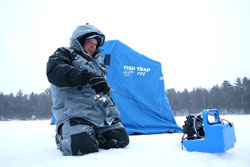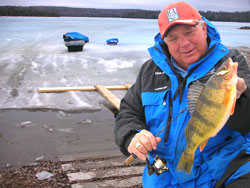For more than 30 years, Dave Genz has been helping modern ice anglers discover the importance of mobility. Move more and you catch more fish.
At the same time, he stresses that you cannot ignore the equally important topic of ice safety while you’re out there.
 Ice conditions vary from spot to spot on the same lake, and tremendously from region to region. In certain locales, ice thick enough to support foot traffic will only remain for several days or weeks at a time. If you feel at all uncertain about ice conditions, wear a life jacket while you’re ice fishing. It never gets discussed in the media, but what better way to ensure your safety? We’ve never heard of anyone falling through the ice and drowning while wearing a life jacket. “If you have a life jacket on,” says Genz, “there’s no way you’re going to fall through the ice and end up on the bottom. Your head will be up, and you can kick your legs, pull, slide and roll back the way you came from.”
Ice conditions vary from spot to spot on the same lake, and tremendously from region to region. In certain locales, ice thick enough to support foot traffic will only remain for several days or weeks at a time. If you feel at all uncertain about ice conditions, wear a life jacket while you’re ice fishing. It never gets discussed in the media, but what better way to ensure your safety? We’ve never heard of anyone falling through the ice and drowning while wearing a life jacket. “If you have a life jacket on,” says Genz, “there’s no way you’re going to fall through the ice and end up on the bottom. Your head will be up, and you can kick your legs, pull, slide and roll back the way you came from.”
After all these years and all those days of first- and last-ice fishing, Genz has yet to fall through, other than having his feet punch through along shore. One of the reasons: he is religious about walking with a chisel, punching the ice ahead of himself as he ventures out. If the chisel pops through with one smart poke, he does the smart thing and retreats.
When is the Ice Safe?
Here are some recognized guidelines for knowing when ice is safe enough to support various modes of mobility, from the Minnesota Department of Natural Resources: (Please note that these guidelines apply for clear, solid ice. If ice begins to form, then a heavy blanket of snow falls on it, that can hamper overall strength of the ice.)
• Wait to walk out until there is at least 4 inches of clear, solid ice. True, thinner ice will support one angler, but ice thickness can vary just a few yards away, from the influence of flocks of waterfowl, water chemistry and local climate.
• Snowmobiles and ATVs need at least 5-6 inches of clear, solid ice.
• Automobiles and light trucks need 8 inches to a foot of good ice. But there’s more to safely driving a vehicle on ice!Keep a distance between vehicles, and don’t follow each other single file (except when you have to, such as when roads are plowed out to fishing areas). When ice is only marginally safe for vehicle traffic, your car or truck makes a wake under the ice. When the wakes of more than one vehicle collide, cars following in close proximity can easily break through ice that safely held the leading cars! Also, no matter how thick the ice, it’s a good idea to drive slowly. A fast-moving vehicle can make a big bulge ahead of itself, and the ice can––it rarely happens, but it can––break apart in front of the fast-moving vehicle.
Obviously, avoid driving into known bad-ice areas, such as springs, moving water, and around aerators. Ask about each lake before you drive on. Also– and this can pertain to walking as well– avoid expansion cracks, or ‘pressure ridges’ as they are sometimes called. They are often easy to see. The ice expands and pushes over the top of itself, creating layers of broken ice. They can be like trap doors, especially where three of them converge.
Be prepared to bail out of a vehicle should it go through. Unbuckle your seat belt, and leave the windows rolled down if you suspect unsafe ice.
• Any time you’re driving a vehicle or snowmobile, watch out for the large blocks of ice sometimes left laying around after large spearing or angling holes are sawed out. After snow covers them up, they can be impossible to see––another reason to drive slowly on ice.
(If you cut such a hole, by the way, either force it down under the ice and off to the side, or break it into little pieces.)
• Get or make a set of “picks” for helping yourself onto safe ice should you fall through. Several types are available at bait shops or through mail-order catalogs. To make your own, take two short sections (about 4 1/2 to 5 inches) of old broom handle or 1-inch dowel. Remove the head of two good-sized nails. Drill a hole in the end of each dowel long enough to seat the ‘unsharp’ end of the nail. Glue the nails in each dowel and tie them together with about 2 1/2 feet of cord. It’s a good idea to jab the sharp ends of the nails into small corks, which will break apart easily when you start jabbing the nails into the ice. Wear the spikes around your neck any time you’re unsure of ice conditions.
All ice is not created equal
 Several factors affect how solidly ice freezes on any given year, according to Sgt. Dave Branley of the Dane County (WI) Sheriff’s Department. Sgt. Branley, with more than 30 years on the force, has been in charge of patrolling his county’s waters, summer and winter, since 1980.
Several factors affect how solidly ice freezes on any given year, according to Sgt. Dave Branley of the Dane County (WI) Sheriff’s Department. Sgt. Branley, with more than 30 years on the force, has been in charge of patrolling his county’s waters, summer and winter, since 1980.
“We need about 6 inches of solid ice before we get the first heavy snowfall on it,” Branley says. “If ice is just starting to be made and then snow falls on it, the weight of the snow pushes the ice down and can insulate it against ever freezing well.”
Your best insurance against getting too far out on unsafe ice, experts agree, is to monitor local media for updates on the current year’s ice conditions, and to talk with local resorts and bait shops, who will know about potential thin ice areas (you could use a few more ice jigs, and some maggots or wax worms, right?).
Ice thickness, in and of itself, is not a guarantee of smooth sailing late in the year. “Travel on ice is always at your own risk,” says Branley, “and you should never assume ice is completely safe. But this is especially true toward spring. I know, the fishing gets great at last ice, but be careful out there. You look out and one day there’s a lot of water on the ice, and the next day it’s completely dry. The ice gets honeycombed and rotten, and eventually you can poke a 2×4 through 8 inches of ice, which used to be enough to support a vehicle.” What if you go through? Sometimes, no matter how careful you are, things happen. If you should fall through the ice while walking:
• Don’t panic. Easier said than done, but it’s fairly easy in most cases to get back up on the ice than you think. Go back the way you came from (you know the ice was thick enough to support you back there).
• All that heavy clothing will actually help you stay afloat if you don’t start flailing away. Kick and fight to keep going forward; your feet will want to float up and you’ll tend to fall backwards. If you have picks along, now’s the time to use them. Get one in each hand and dig them alternately into the ice and pull yourself forward. To get onto good ice, roll away from the hole, or continue to work with the picks, sliding ahead on your belly (don’t get up and start walking or you might break through again).
• Get to a heat source immediately and get those wet clothes off! If at all possible, get to a medical facility to be checked for signs of hypothermia and/or other trauma.
• If you see someone go through, designate one person to go for help, and another person to attempt the rescue. Don’t walk right up to the victim and offer them your hand; that usually results in two people in the water. Build a chain with anything you can find: a snowmobile suit, hand auger, your belt, etc. Lay down and extend the ‘chain’ to the victim. Get secure and help pull them out of the hole, encouraging them to kick hard and stay down. “We bring a throwable (personal flotation device, or PFD) tied to a rope,” says Genz, “at first and last ice. If somebody would go through, you can toss the cushion to them, and they hold it while you pull them up onto the ice.” Your chances of breaking through the ice are slim, indeed, as long as you follow these precautions and use a good dose of common sense. Note: Dave Genz, known as Mr. Ice Fishing, was the primary driver of the modern ice fishing revolution. He is captain of Clam’s Team True Blue, an elite pro staff dedicated to helping people catch fish through the ice.










